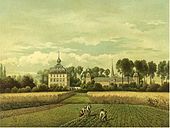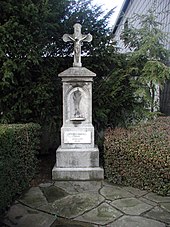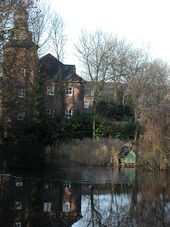Kendenich
Kendenich is a district of the city of Huerth in the Rhein-Erft district , North Rhine-Westphalia . Kendenich has 2,982 residents (as of October 31, 2008).
location
Kendenich lies on a Riedel , an undulating slope of the foothills , with an extensive view of the Rhine Valley. The place is mainly surrounded by agricultural land.
history
Roman times
Even in Roman times there must have been a larger building on the site of the current castle. This is evidenced by the uncovered remains of Roman masonry during excavation work in a basement, as well as exposed Roman paving in an orchard. In the moat to Roman found urns , brick fragments of the same period have been found at the eastern exit of the villa.
A large number of coins from Roman emperors found in Kendenich (in the churchyard and on the outskirts) are said to have been in the possession of the later lords of Kempis.
middle Ages
The place is first mentioned around 941, when the Archbishop of Cologne Wichfrid donated the tithe from the manor house in Cantenich to the Cäcilienstift in Cologne . The derivation of Cand in Gallic equal to 100 (Latin Centum ) is no longer used. So the assumption that in Franconian times this place was the meeting place of a centena or a hundred , a subdivision of the old Gau , the Kölngau , and thus also the place of jurisdiction and residence of a Centenarius or Centgrave is invalid. Wilhelm Kaspers derives the name from Galisch Canto (Latin candidus) white . That also seems absurd. Leonard A. Curchin, on the other hand , concludes that the Celtiberian city of Centobriga has a Celtic meaning for cento / cinto, which means "first", "erect", "beginning", i.e. foremost or even the most elegant castle. The same could apply to Kendenich, although the suffix -acum only means a place name. The castle is still a landmark of Hürth today.
The rule , called Kentenich in 1159, was, however, the seat of an independent jurisdiction in the Amte Brühl until secularization .
Among the named followers of the Cologne bishops in the 12th and 13th centuries, the Lords of Kendenich are also listed. The designation " Domini ", ie gentlemen, indicates that they had their own territory with independent jurisdiction. Lords of Kendenich were the Birklin in the 12th century , they came from a respected patrician family from Cologne.
In 1269, Phillip, Vogt von Kendenich, appears as a witness in a document in which an arbitration decision was made about the jurisdiction for those who were justified between the noble lord Conrad von Schleiden and the Steinfeld Abbey .
In 1443 a Heinrich von Kendenich, at the same time " Drost " von Brühl, reached an agreement with the city of Cologne regarding the water rights of the Hürth Duffesbach . So it says:
.. " He allows her because of the friendship that has been shown to him, where other sources should show themselves, to lead them into the brook and carry them on ".
The family of the Knights of Kendenich can be proven by documents from Cologne, Brauweiler and Brühl (this is mostly about disputes), but also by land sales to the Carthusians in Cologne until the late 15th century, then the name disappears.
Around 1475 the nobleman Mathias Walraven, Lord von Kendenich is called. The Walraven belonged to the Cologne nobility, some were mayors of the city. In 1517 Dham von Orsbeck owned the house of Kendenich, with all " justice and accessories ". He was enfeoffed by a loan letter from the Elector Hermann V. (Count von Wied)
After later disputes over inheritance, the Orsbeck family came to an agreement on the division of property. The certificate of division from October 1550 describes the house and farm of Kendenich as follows:
… “ With its fortress, gardens, dams, ponds, with all its justice, fisheries, smoking hens and wine house in the village and the Weinzapp, as we have inherited from father and mother, as well as everything else, land, sand, bush, vineyards and Pit leasing ".
Around 1560, half of the ownership went to Agnes von Orsbeck and Adam von Orsbeck, who then built a new house with a courtyard, the Orsbecker Hof. Both estates retained the rights of noble seats.
Agnes von Orsbeck married Adolfph Freiherr Raitz von Frentz and brought the castle house into this family with fiefs and allodial property (aldermen, sovereign rights). The Orsbeck court, on the other hand, was only allodial.
Through Dham (Adam) von Orsbeck, the aristocratic Orsbeck court came to the Barons Raitz von Frentz zu Stolberg around 1569 and was given the name Frentzer Hof. The castle house itself remained in the possession of the Barons Raitz von Frentz, who later also called themselves " zu Kendenich ", for over a hundred years . The following gentlemen, all but the last of whom carried the name Adolph, increased the property through several purchases. This is evidenced by feudal letters from 1605 and 1615. The last lord of this line was Johann Sigismund Freiherr Raitz von Frentz, Gubernator zu Kaiserswerth, enfeoffed in 1659. With him, the male line of Baron Raitz von Frentz zu Kendenich dies out.
By marrying his daughters, property and fiefs came to the barons of Reuschenberg , who were enfeoffed for the first time in 1690 and further by succession in 1704. Edmund von Reuschenberg zu Kendenich was the last to receive the fief in 1752 from the Elector Clemens August . Under Edmund Freiherr Raitz von Frentz , the estate ran into financial difficulties. It was so in debt that it went up for sale in 1764. In August 1764, the noble knight's seat Kendenich and all associated goods were valued at 62,549 Reichstaler.
The mayor of the imperial city of Cologne, Maria Franz Gabriel Groote, Lord of Thurn and Wolfskehl, bought the estate in 1766 at a court-scheduled sale at a price of 47,000 Reichstaler . He was raised to the rank of imperial knighthood by Emperor Joseph II in February 1780 and was allowed to call himself "Edler von Groote zu Kendenich".
The Modern Age
Kendenich experienced its most glamorous time under Maria Franz Gabriel Groote, who in 1766 was the last to acquire and rebuild the Kendenich Castle. For almost two centuries the place remained the seat of this noble family from Cologne.
In the course of the generations, all lords of the castle endeavored to enlarge their extensive estates through further land purchases. The local court and the stately wine house of the "Lockmeis" belonged to the castle. Wine was grown on its own floe, the Wingert, on which some Kendenich citizens also owned parcels. The wingert was located above the Kendenich channel, at the foot of the so-called gravel mountain. The citizens themselves referred to the wine as "Surer Honk" (sour dog).
Kendenicher Höfe
In addition to the castle, church and rectory, there were five large farms in Kendenich around 1780. The Fronhof, the Frentzenhof, the Abtshof, the Pflügershof and the Ortshof belonging to the castle. The Kalscheurerhof with its chapel in the otherwise still deserted neighboring hamlet of Kalscheuren was also part of Kendenich.
French period
After the vineyards were devastated by the invading French military in 1794, large-scale viticulture was no longer started in this area. Kendenich belonged to the canton of Brühl until 1814 .
19th century
The oldest part of Kendenich with its nearly 3000 inhabitants today can be found in the lower part of the village: Pützstraße, In der Aue, in the "Jordan" (Ortshof-, Fuchs- and Fischenicher Straße). Here you can still find some old houses (also restored former cottages of the day laborers ), which were built around 1830. The center of the village lay on the source horizon of the many small pits lying in the outflowing layers of brown coal , which also fed the castle pond.
(→ Brown coal in Hürth and Rhenish brown coal area )
The early lignite mining in the outskirts of Kendenich, the Kentenich Turffgruben on the Kranzmaarbach, is first mentioned in 1750. The first concession for the Kendenich field was granted in 1866 for later industrial mining. The actual opening up began in 1884 with the Rhineland Trade Union , which later became Ribbertwerke in neighboring Hermülheim, and indirectly led to a major restructuring of the place. In addition to the large manors, there have always been a few smaller farms, but now many day laborers have settled there too. They changed the appearance of the town by building modest little houses called "Kotten". Some are still in the original, others in a modified form in today's cityscape.
In January 1816, the church council bought the "one quarter and 18 rods " large church garden, which until then belonged to the Frentzenhof, from baron Franz Ludwig von Beissel for 100 Reichstalers.
The property opposite the church with the pastorate building was surrounded by a massive wall in 1863 and is still preserved in this form today.
In 1839 the civil parish erected a first school building with two classrooms and a teacher's apartment. A new building followed in 1874, and the building was expanded to include a third school class in 1885. The number of school-age children for 1886 was given as 173 pupils.
In 1887 the place had a total of 187 houses with 919 residents, 907 of them Catholic , 2 non-Catholic (presumably Protestant) and 10 Jewish .
Kendenich today
Mayor
The mayor has been Frank Baer (SPD) since 2010 (as the successor to Peter Berger), who continues to hold this office after the 2014 election.
Schools / sports
- Community elementary school Kendenich, Ortshofstraße 20
- Secondary school Kendenich, Steinackerstraße 6
- SV Kendenich
The round cycle race in Hürth-Kendenich has been held in Kendenich since 1985 .
Attractions
- The place is one of the stations of the Roman Canal hiking trail .
- The Kendenich moated castle dates back to the 10th century and has now been converted into a residential complex.
Churches
- Sankt Johann Baptist and rectory
Main article: St. Johann Baptist
The tower of the Johannes Baptist parish church dates from 1682. In 1875 the organ builders Kalscheuer from Nörvenich built an organ here for 1162 thalers. When today's church was built in 1956, remains of a previous building from the 10th century and remains of an even older half-timbered building were found. A Romanesque church stood here in the 13th century, which was renovated and expanded in 1859. The tower from 1682 still stands today. The most valuable jewelry is a forked cross from 1350/60. The parsonage from the turn of the 19th and 20th centuries was designed by the Cologne church architect Theodor Ross. On the recommendation of the landscape association , it is placed under monument protection, as is the parish hall and garden.
- The Evangelical Nathan Söderblom Church
Main article: Nathan Söderblom Church
It was not until January 1, 1957 that all of the Evangelical Christians residing in the large civil parish of Hürth united to form the new Evangelical Church of Hürth. The Protestant Nathan Söderblom Church was built in 1973 as a replacement for the Dankeskirche of the relocated Knapsack, which was demolished in 1976, in the immediate vicinity of the Catholic Church. The separate tower in the style of a Swedish / Norwegian stave church with the Knapsacker bell was built in 1981. Kendenich had thus taken over from the Knapsack district. For financial reasons, on June 15, 2008, the church in Kendenich was divested. Equipment and baptismal fonts were transferred to Hürth-Mitte. A dance studio moved into the building. The pastor's office was abolished and the district divided. The district of Kendenich is now supplied by the pastor of the Friedenskirche Efferen .
literature
- Robert Wilhelm Rosellen: History of the parishes of the deanery Brühl , JP Bachem Verlag Cologne 1887
- German Hubert Christian Maaßen : The Roman state road from Trier via Belgika to Wesseling on the Rhine and the Roman Canal on the foothills . In: AHVN 37 (1882). Pp. 1-119.
- Jacob Grimm, Wilhelm Grimm (Brothers Grimm): German legends. Kassel 1816/18, No. 79
- Hürther Heimat, magazine for history, culture and local history - Volume 71/72, 1993
- Clemens Klug: The medieval glory Kendenich - A Kurkölner manorial rule , home and cultural association (ed.), Hürth 1972
Individual evidence
- ↑ according to Maaßen
- ↑ In summary, Klug, Kendenich , p. 14
- ^ The -acum place names of the Rhineland , Halle 1921, p. 7
- ↑ Fife Celtic Town-Names in Central Spain online (p. 46)
- ↑ after Rosellen, there inscribed "akatholisch"
- ↑ According to the city of Hürth website as of June 2014
- ↑ Kölner Stadtanzeiger, Rhein-Erft, from March 14, 2008
Web links
Coordinates: 50 ° 52 ' N , 6 ° 53' E














